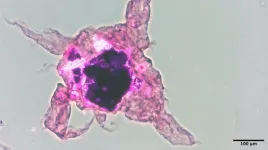Researchers from Mass Eye and Ear conducted a clinical trial of sodium oxybate, an oral medication used to treat narcolepsy, for the treatment of laryngeal dystonia, an often-debilitating neurological condition that impacts speech. Trial was borne out of patient reports of symptom improvements after consuming alcohol. A single dose of sodium oxybate significantly improved symptoms for alcohol-responsive patients, with effects lasting up to 5 hours. The trial involved participants from across the U.S., U.K., and Canada and brings hope to the laryngeal dystonia community, who currently lack effective oral medications.
Laryngeal dystonia (LD), a rare neurological disease that significantly impacts a person’s ability to speak due to uncontrollable vocal cord spasms, can have a debilitating effect on a person’s social life, employment and mental health. Currently, LD is most commonly managed with botulinum neurotoxin (Botox) injections, but this treatment is ineffective for up to 40% of patients who receive it. Now, a study led by researchers from Mass Eye and Ear, a member of the Mass General Brigham healthcare system, shows that an oral medication, sodium oxybate, is more effective than placebo at reducing LD symptoms in patients whose symptoms improve when they consume alcohol.
The results from the phase 2b randomized clinical trial, published November 20th in Annals of Neurology, build on more than a decade of research spurred by anecdotal reports from patients with LD who said their symptoms improved after consuming a couple alcoholic drinks. Sodium oxybate is a central nervous system agent that is FDA-approved to treat patients with narcolepsy and sleep disorders. Sodium oxybate mimics some of the effects of alcohol.
In the trial of more than 100 patients, a single dose of sodium oxybate significantly improved symptoms of patients with alcohol-responsive LD without causing serious side effects. The minimum efficacy of the drug was 16% of voice improvement, with the average of 41% in patients with alcohol-responsive LD. Sodium oxybate showed no significant changes from placebo in LD patients whose symptoms do not improve with alcohol.
“We hear many stories of broken lives and careers from patients with laryngeal dystonia and they have been desperate for new treatments. Our trial gives us hope for a new, effective treatment that can be offered to some of these patients,” says lead author Kristina Simonyan, MD, PhD, Dr med, vice chair for clinical research in the Department of Otolaryngology-Head and Neck Surgery at Mass Eye and Ear and professor of Otolaryngology-Head and Neck Surgery at Harvard Medical School. “There's a lot of interest from the dystonia community, and we get many calls from patients asking, ‘When will this drug be available? How can I have a prescription?’”
Laryngeal dystonia, known previously as spasmodic dysphonia, is a rare condition that affects over 50,000 people in the US and Canada. It is more common in women than men and typically onsets in 40s, often taking a significant toll on their quality of life. Its exact neurological cause is unknown, and patients on average take up to 5.5 years to receive a correct diagnosis. Once diagnosed, treatment options are limited to Botox injections every three-to-four months for life, if effective.
In previous open label trials, Simonyan’s team showed that sodium oxybate improves voice symptoms in 82% of patients with alcohol-responsive LD. In their new study, the team wanted to confirm the drug’s efficacy in a more rigorous comparison against a placebo using a double-blind randomized clinical trial design.
The investigators enrolled 106 participants with LD, 50 of whom had alcohol-responsive symptoms. Alcohol responsiveness was determined by a standardized alcohol challenge test using a controlled amount of vodka. Participants traveled from across the U.S., the U.K. and Canada to participate in the trial—testimony to the excitement that this drug offers to the dystonia community. Over the course of two days, each patient received single doses of 1.5g of sodium oxybate or placebo that was matched by its taste, smell, color, and appearance to the drug. The trial was conducted in a double-blind fashion, meaning that neither patient nor clinician knew when they received the active drug. To test the treatment’s effectiveness, the team assessed the patients’ voice symptoms before the treatment and different intervals after the treatment.
Sodium oxybate was significantly more effective at reducing symptoms than placebo for patients with alcohol-responsive LD but not those whose symptoms do not improve with alcohol. The efficacy of sodium oxybate in alcohol-responsive LD did not differ between patients with various symptom severity (mild to severe) or those who had additional voice symptoms, such as voice tremor.
Voice symptoms in alcohol-responsive LD patients significantly improved about 40 minutes after drug intake, with the benefits lasting up to 5 hours. Though some patients experienced mild and transient side effects such as nausea, dizziness and daytime sleepiness, there were no serious adverse events and no rebound in symptom severity after the drug wore off.
“Our findings suggest that sodium oxybate can be taken on an as-needed basis, such as before work or a social event, so patients can tailor treatment to their own daily needs and get in control of their symptoms,” said Simonyan.
Looking ahead, Simonyan’s team is planning to conduct a phase 3 multi-site randomized clinical trial to further assess the drug’s efficacy and safety in LD patients. Her lab is also leading studies using artificial intelligence to determine which patients might benefit from the treatment as well as alternative treatments for LD patients whose symptoms are not responsive to alcohol.
Authorship: In addition to Simonyan, study co-authors include Lena C. O’Flynn (MEE), Azadeh Hamzehei Sichani, MA (MEE), Steven J. Frucht, MD (NYU), Anna F. Rumbach, PhD (Queensland), Nutan Sharma, MD, PhD (MGH), Phillip C. Song, MD (MEE) and Alexis Worthley (MEE).
Disclosures: The authors report no conflicts of interest.
Funding: This study was funded by the National Institute on Deafness and Other Communication Disorders of the National Institutes of Health, grant R01DC012545.
Paper cited: Simonyan, K et al. “Efficacy and Safety of Sodium Oxybate in Isolated Focal Laryngeal Dystonia: A Phase IIb Double-Blind Placebo-Controlled Cross-Over Randomized Clinical Trial” Annals of Neurology DOI:10.1002/ana.27121
###
About Mass Eye and Ear
Massachusetts Eye and Ear, founded in 1824, is an international center for treatment and research and a teaching hospital of Harvard Medical School. A member of Mass General Brigham, Mass Eye and Ear specializes in ophthalmology (eye care) and otolaryngology–head and neck surgery (ear, nose and throat care). Mass Eye and Ear clinicians provide care ranging from the routine to the very complex. Also home to the world's largest community of hearing and vision researchers, Mass Eye and Ear scientists are driven by a mission to discover the basic biology underlying conditions affecting the eyes, ears, nose, throat, head and neck and to develop new treatments and cures. In the 2024–2025 “Best Hospitals Survey,” U.S. News & World Report ranked Mass Eye and Ear #4 in the nation for eye care and #6 for ear, nose and throat care. For more information about life-changing care and research at Mass Eye and Ear, visit our blog, Focus, and follow us on Instagram, Twitter and Facebook.
END





